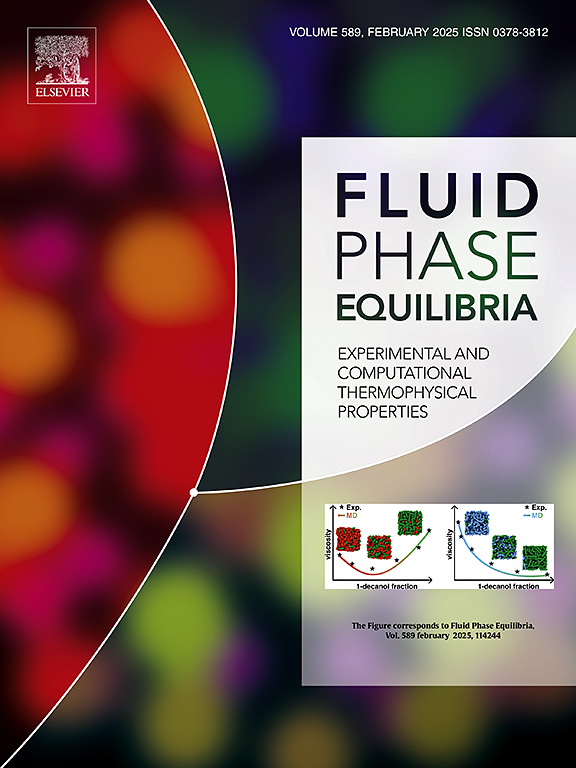Adsorption-desorption hysteresis of gas mixtures/graphite system through molecular simulation: Implications for gas separation membrane technology
IF 2.8
3区 工程技术
Q3 CHEMISTRY, PHYSICAL
引用次数: 0
Abstract
Graphite could potentially serve as a membrane for enhanced gas separation in the petroleum sector. The extraction of in-situ hydrogen (H2) in natural gas reservoirs will be challenging due to the presence of methane (CH4) and carbon dioxide (CO2). A downhole wellbore membrane to selectively produce hydrogen while prohibiting the flow of CO2 and other gases would improve economic viability. However, investigations on graphite for gas transport of CO2, H2, and CH4 in terms of hysteresis have received little attention. For this paper, we used molecular dynamics simulation to investigate H2, CO2 and CH4 adsorption/desorption behavior on graphite under various pressures (2.75–41.37 MPa) and temperatures (350 K). By combining Grand Canonical Monte Carlo with molecular dynamics, the simulation not only investigates sorption but also examines the interaction between graphite and gases. Our results indicate that the adsorption capacity is directly correlated to pressure and the adsorption curve reaches the maximum at a high pressure of 41.37 MPa. At extreme pressures, the rate of adsorption increases, but at a lower pressure indicating limited availability of adsorbent pores. The sorption capacity non-linearly with pressure limits both the adsorption and desorption process with a maximum sorption capacity of about 11.3 mmol/g for H2, 17 mmol/g for CH4 and 43 mmol/g for CO2 at a pressure of about 40 MPa. The desorption curve slightly overlaps the adsorption curve and marks the hysteresis effect between the two processes of adsorption and desorption. The effect of hydrogen on the graphite is less than carbon dioxide or methane. The discrepancy among adsorbent preferences for carbon dioxide arises from size, polarizability or interaction energy. In terms of diffusion coefficients, hydrogen can be said to have a higher diffusion coefficient than that of carbon dioxide while carbon dioxide has a higher one when compared to methane, probably due to its lighter molecular weight and weaker adsorption.
气体混合物/石墨体系的吸附-解吸滞后分子模拟:对气体分离膜技术的启示
石墨有可能作为一种膜,用于石油部门加强气体分离。由于存在甲烷(CH4)和二氧化碳(CO2),天然气储层中原位氢气(H2)的提取将具有挑战性。一种井下膜可以选择性地产生氢气,同时阻止二氧化碳和其他气体的流动,这将提高经济可行性。然而,关于石墨对CO2、H2和CH4气体输运迟滞的研究很少受到关注。本文采用分子动力学模拟方法研究了不同压力(2.75 ~ 41.37 MPa)和温度(350 K)条件下石墨对H2、CO2和CH4的吸附/解吸行为,并将分子动力学与大规范蒙特卡罗方法相结合,不仅研究了石墨对H2、CO2和CH4的吸附,还研究了石墨与气体之间的相互作用。结果表明,吸附量与压力直接相关,在41.37 MPa的高压下吸附曲线达到最大值。在极端压力下,吸附速率增加,但在较低的压力下,表明吸附剂孔隙的可用性有限。吸附量与压力呈非线性关系,在压力约为40 MPa时,H2、CH4和CO2的最大吸附量分别为11.3 mmol/g、17 mmol/g和43 mmol/g。解吸曲线与吸附曲线略有重叠,标志着吸附和解吸两个过程之间的滞后效应。氢气对石墨的影响小于二氧化碳或甲烷。吸附剂对二氧化碳的偏好差异来自于吸附剂的大小、极化率或相互作用能。在扩散系数方面,可以说氢气的扩散系数高于二氧化碳,而二氧化碳的扩散系数高于甲烷,这可能是由于氢气的分子量较轻,吸附能力较弱。
本文章由计算机程序翻译,如有差异,请以英文原文为准。
求助全文
约1分钟内获得全文
求助全文
来源期刊

Fluid Phase Equilibria
工程技术-工程:化工
CiteScore
5.30
自引率
15.40%
发文量
223
审稿时长
53 days
期刊介绍:
Fluid Phase Equilibria publishes high-quality papers dealing with experimental, theoretical, and applied research related to equilibrium and transport properties of fluids, solids, and interfaces. Subjects of interest include physical/phase and chemical equilibria; equilibrium and nonequilibrium thermophysical properties; fundamental thermodynamic relations; and stability. The systems central to the journal include pure substances and mixtures of organic and inorganic materials, including polymers, biochemicals, and surfactants with sufficient characterization of composition and purity for the results to be reproduced. Alloys are of interest only when thermodynamic studies are included, purely material studies will not be considered. In all cases, authors are expected to provide physical or chemical interpretations of the results.
Experimental research can include measurements under all conditions of temperature, pressure, and composition, including critical and supercritical. Measurements are to be associated with systems and conditions of fundamental or applied interest, and may not be only a collection of routine data, such as physical property or solubility measurements at limited pressures and temperatures close to ambient, or surfactant studies focussed strictly on micellisation or micelle structure. Papers reporting common data must be accompanied by new physical insights and/or contemporary or new theory or techniques.
 求助内容:
求助内容: 应助结果提醒方式:
应助结果提醒方式:


